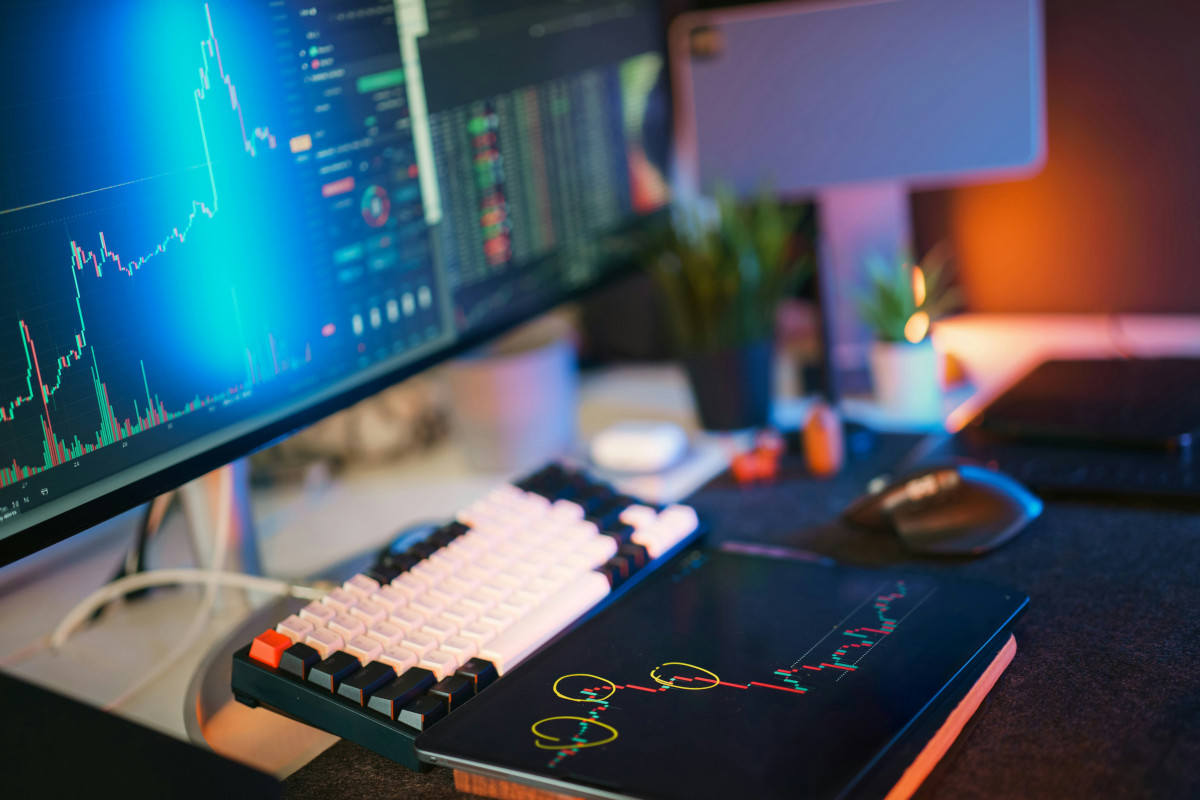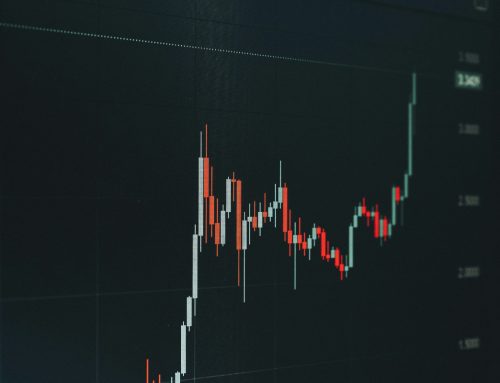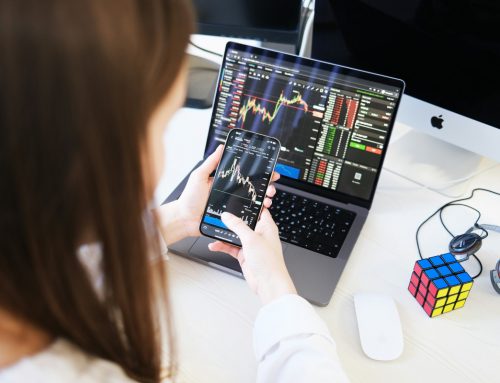The AI revolution is well underway, like it or not. Every industry imaginable is being touched in some way or another. Investing is no exception. More and more investors are using AI to trade stocks, and you can too. We’ll show you how to use AI to trade stocks today.
But, it’s important that you set your expectations with AI stock trading. It sounds great in theory – you can analyze thousands of data points in seconds and remove human biases from trades. Not all AI stock tools are created equal, though – and that distinction matters.
Relying on AI for stock trading can cost you greatly if you aren’t starting with high-quality data, or rely on false signals from noisy market data. AI doesn’t take responsibility for losses, either. You still need human oversight to make the most of AI stock trading.
You may already be engaging in some form of AI stock trading without knowing it if you use a stock forecasting software, like VectorVest. Our proprietary algorithms rank 18,000+ stocks on a daily basis based on value, safety, and timing.
The VectorVest system takes complex technical data and fundamental information and boils it down into clear, actionable insights – saving you a ton of time and stress while empowering you to win more trades with less work.
You can learn more about using AI to trade stocks below. Otherwise, we encourage you to get started with our stock advisory today, whether you’re a swing trader or buy-and-hold investor, and see your success rate skyrocket while your time wasted in front of a screen plummets!
Can You Use AI to Trade Stocks?
First things first, can you use AI to trade stocks? Yes, but you have to understand how it works and what it actually does – and of course, what it cannot do.
AI (artificial intelligence) stock trading relies on machine learning models or algorithmic systems to analyze data and generate subsequent trade signals, predictions, or portfolio recommendations.
These systems don’t think like humans – which can be a good and bad thing. It means they sometimes lack nuance. But they also lack human emotion, which has cost people plenty of trades.
AI stock trading bots detect patterns, identify correlations, and make decisions based on historical and real-time inputs. There are three functional buckets most AI stock trading tools fall into: prediction, classification, and automation. Here’s how each works.
Predictive Analytics
These forecast price movements based on historical patterns and market signals, relying on technical indicators, earnings data, economic reports, and volume trends. Some also incorporate search trends or insider activity.
Classification/Signal Generation
This type of AI sorts stocks into groups based on user-defined traits, like strong earnings, upward momentum, or undervaluation. Watchlists get generated based on those conditions, and stocks can be flagged as “Buy,” “Watch,” or “Avoid.”
Some tools layer in sentiment analysis using NLP (natural language processing), scanning news headlines or earnings call transcripts to assign scores based on tone or keyword shifts.
Automated Execution and Strategy Optimization
This is what a lot of investors look for when asking how to use AI to trade stocks. They want something that actually does the work for them. These types of systems may automatically enter or exit trades based on model outputs or market triggers.
A few use reinforcement learning, which is central to any AI system. They get better over time based on how trades are performing. Sounds great in theory, but as we’ll explain below, no system is truly “hands off” – at least, not if you want to protect capital!
Pros and Cons of AI Stock Trading
We understand why so many investors are interested in using AI to trade stocks. Manual fundamental and technical analysis is incredibly time-consuming, and it’s all too easy to get in your own way and let human error or emotion cloud your judgment.
But it’s imperative to understand both the good and bad when it comes to AI stock trading. Here are the pros and cons of incorporating AI for stock trading.
Advantages of Using AI to Trade Stocks
- Speed: AI models can analyze large datasets in seconds – far faster than any manual process. That includes historical price action, earnings revisions, sector momentum, and even real-time news sentiment. Spot setups that meet your criteria without spending hours sorting through charts or reports.
- Consistency: Unlike humans, AI doesn’t get tired, second-guess itself, or panic. It applies the rules the same way every time after you define them. That helps you avoid emotional trades or inconsistent execution.
- Pattern Recognition: AI is good at detecting patterns that aren’t obvious to the eye, especially in high-dimensional data. Some models look at price movement across hundreds of stocks to uncover correlations or leading indicators that signal an opportunity.
- Backtesting and Optimization: AI lets you test strategies on historical data to see how they would have performed. Some even auto-optimize position sizing or rule sets based on that backtest.
- Passive Monitoring: AI can scan for trade setups that match your parameters, and you get alerts without staring at the screen all day. Some platforms even let you run multiple strategies at once, each with its own rules.
The Drawbacks and Limitations of Using AI to Trade Stocks
- Lack of Transparency: Most retail-level AI tools don’t explain why a trade signal is triggered. You’re given a rating, a chart, or a watchlist without the logic behind it. Some investors have a hard time trusting the signal.
- Data Quality Problems: AI is only as good as the data you feed it. A platform using incomplete or lagging data makes your model’s output unreliable. Retail tools rarely disclose their data sources or how they clean that data.
- Overfitting: AI strategies might perform well in backtests but fall apart in live markets. That’s usually because the model was trained on noise (not signal) and can’t adapt when the market changes.
- No Context: AI can recognize historical patterns, but it doesn’t understand market context the way you do. For example, a momentum signal might trigger the day before a rate announcement or earnings call. The model won’t account for that unless it’s specifically trained to (most aren’t).
- You Still Have to Make the Call: Unless you’re using a fully automated system (which most retail traders don’t) you still have to interpret the output and decide what to do. That means you’re back in the loop, making subjective calls based on signals you might not fully understand.
AI definitely has its place in stock trading. But it’s not the end-all be-all. You need to use it as part of your trading arsenal rather than following its suggestions blindly. It’s also important to choose an AI trading tool you can actually trust.
That said, let’s get into how to use AI to trade stocks below.
How to Use AI to Trade Stocks: A Step-by-Step Guide to Using AI to Trade Stocks
AI can speed up your decision-making by taking complex, convoluted data and helping you make sense of it at a glance. But it’s not going to take your $10,000 and compound it to $100,000 at a 100% success rate, and frankly, it won’t even trade for you out of the box.
We want to walk you through how to use AI to trade stocks the right way so you can tap into the benefits it has to offer without falling victim to common misconceptions.
Step 1: Choose the Right AI-Powered Trading Platform
Start by deciding what you want the AI to actually do. Are you looking for stock ideas based on value or momentum? Are you hoping to automate an existing strategy? Or do you want help interpreting market data?
Some platforms will bring you short-term trade ideas based on backtested signals. Others let you build logic-based strategies that rebalance automatically.
The problem is, not every tool is transparent about how it works. A platform that won’t show you the inputs and logic behind its outputs is a red flag. You need to feel confident in what ata the model is using, how often it updates, and how it decides what to bring to show you.
Step 2: Define Your Strategy and Risk Tolerance
AI needs structure. That means you have to define the rules. There may be some default rules built into your AI stock trading tool, but you can probably fit them to your exact strategy.
Think about it. If you don’t know whether you’re trading breakouts, mean reversion, or earnings momentum, the model won’t know either. You’re just going to get broad recommendations and noisy outputs that don’t really serve you.
Start by writing down the basic logic behind your trades. That could be something like:
- “Buy when price breaks above 50-day moving average and RSI is below 70”
- “Sell if price drops 8% from peak or MACD crosses down”
Then ask yourself how much you’re willing to risk per trade, how often you want to rebalance, and what your time horizon is. The AI can optimize based on those inputs.
Step 3: Train or Customize the AI (If Possible)
Like we just said, a lot of people using AI to trade stocks rely on pre-built models. That’s not a bad thing, but others let you build your own strategies using conditional logic, indicators, or data pipelines.
We recommend keeping it simple if you’re customizing a model. Overcomplicated logic tends to overfit the data. In other words, it’ll look good in backtests but fail in live markets.
Focus on rules that are easy to understand and apply consistently. Don’t load up on 10 different indicators just because the tool allows it. The goal is clarity, not complexity. See if the tool gives you control over which data feeds the model uses (real time vs delayed, fundamental vs technical, etc.).
Step 4: Run Backtests and Analyze Historical Performance
There’s going to come a time where you’re finally ready to start using AI to trade stocks – but you need to trust your system to fully maximize it. That’s why you should backtest it over multiple time frames and market conditions to identify any flaws before you go live.
Don’t just look at total return. You need to dig into:
- Win rate
- Average return per trade
- Maximum drawdown
- Sharpe ratio or Sortino ratio
- Performance during bear markets vs bull markets
Always remember that historical performance is a reference, not a guarantee.
Step 5: Validate Your AI With Paper Trading Before Using Real Money
It’s worth paper trading the strategy for at least a few weeks before you start executing real trades with real capital. This lets you deal with slippage, delays, and unexpected volatility when the stakes are low.
Pay attention to how signals show up. Are they actionable? Are they showing up in time or after the window of opportunity has closed? Do you actually feel confident pulling the trigger when the AI gives you a buy or sell?
If something feels off in paper trading, it will feel worse when real money’s on the line. This is your last chance to make tweaks and build confidence before you put real capital into play.
Step 6: Monitor and Adjust Based on Market Conditions
There you have it, how to use AI to trade stocks. At this point you’re ready to put your system into practice and let it bring you opportunities and insights in real-time.
No AI stock trading system is truly set-it-and-forget-it, though. You need to track performance regularly and adjust when things change. Constantly ask yourself:
- Is the strategy still following the logic you set?
- Are the alerts still timely and relevant?
- Is performance deteriorating during specific market phases?
Sometimes the issue is your inputs, like a rule that doesn’t work in the current environment. In other cases, it’s the data source holding you back. Either way, don’t let the system drift.
VectorVest is Easier and More Accurate Than Using AI to Trade Stocks
Whether you’re searching for the best stocks for covered calls or aggressive growth stocks, VectorVest helps you find winning opportunities on autopilot – and then capitalize on them with confidence and precision.
It’s a proprietary stock rating system with a technical layer of AI built inside – but not the kind that forces you to train models or interpret black-box outputs. The system has been iterated over a few decades. We’ve done the heavy lifting, so you can just enjoy smarter investing.
It uses advanced mathematical modeling to analyze more than 18,000 stocks daily and score each one on value, safety, and timing. But instead of giving you a score and expecting you to make sense of it, VectorVest goes one step further: it gives you a clear buy, sell, or hold rating for every stock, every single day.
The system uses real-time data from the Nasdaq Last Sale (NLS) feed, so there’s no question marks about where these recommendations or insights are coming from, either. VectorVest has outperformed the S&P 500 index by 10x over the past 20 years and counting, calling every major market move along the way.
You also get the logic behind the ratings. You can see how every stock scores based on relative value, how stable its financials are, and how strong its current momentum is. And unlike most AI tools, VectorVest tells you when to be in the market and when to sit out, thanks to sentiment analysis.
In looking at recommendations for Motley Fool alternatives, Seeking Alpha alternatives, Tradingview alternatives, and even Finviz alternatives, VectorVest is often at the top of the list. Find out why for yourself with a free stock analysis today!
Final Words on AI Stock Trading
That does it for our guide on how to use AI to trade stocks. AI can help you process more data, move faster, and avoid emotional trades – but most of the time, you’ll find that using AI to trade stocks leaves you with more questions than answers.
You still have to define your own strategy, interpret complex signals, and constantly tweak your system to stay on track. That’s why you may be better off using a system like VectorVest that does all the heavy lifting for you, and just leaves you to actually execute the trade.
Our blog has more resources on topics like penny stock apps or the best day of the week to buy stocks. At this point, the only thing left to do is get started trading with the VectorVest system. Get clear, data-backed guidance on what to buy, when to buy, and when to sell!
What you should do next…
- Get our latest blogs delivered right to your inbox, subscribe to our newsletter.
- The market moves fast! Get our most current evaluation of this stock with our FREE stock analysis tool.
- Looking for stock picks? Not sure if now is the right time to buy/sell? For a limited time, enjoy the full benefits of a 30-day subscription to VectorVest for only $9.95 (usually up to $139/month) . Get access to our full list of screeners showcasing our top stock picks that tell you exactly what to buy, when to buy, and when to sell.







